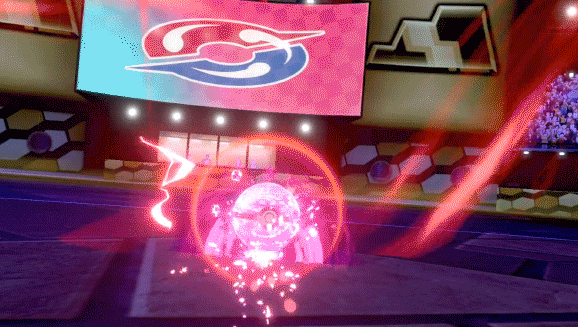By Barış Akcoş, Contributing Writer
With the release of Pokémon Sword and Pokémon Shield, Pokémon Trainers were introduced to a new battle mechanic in the form of Dynamax and Gigantamax. Competitors could now Dynamax one Pokémon per battle, creating both an exciting visual spectacle and a massive increase in Pokémon power that has a sizable impact on battles. Trainers began to develop new strategies on their way to mastering the Dynamax phenomenon, with the outcome of many battles coming down to whether Trainers could take full advantage of their Dynamax turns at pivotal moments in a match. Check out our previous article about Dynamax for insight about how it works.
The excitement does not stop there, though, as Gigantamax adds another wrinkle. In addition to the benefits of Dynamax, Pokémon that Gigantamax change their appearance and gain access to an exclusive G-Max Move! During some special events in the Wild Area, certain Gigantamax Pokémon are more likely to appear. After these events, featured Gigantamax Pokémon are added to the official Pokémon Video Game Championships (VGC) rules in waves for official competitions. As of May 1, Series 4 was formally introduced and now all known Gigantamax forms currently available in the base versions of Pokémon Sword and Pokémon Shield are legal, including the most recent additions of Gigantamax Machamp, Gengar, Garbodor, Copperajah, and Duraludon. Each of these new Gigantamax Pokémon bring new and exciting possibilities to the competitive metagame, but before we review them in detail, let’s recap which Gigantamax forms were successful throughout Series 3.
Series 3 Gigantamax Pokémon
Gigantamax Lapras

Our first Series 3 recap focuses on fan favorite Lapras, which arrives in the Galar region with one of the best defensive G-Max Moves. G-Max Resonance is a strong Ice-type attack that reduces both physical and special attack damage to Pokémon on its side of the field by setting up Aurora Veil. Following up G-Max Resonance with powerful Max Geyser attacks, Gigantamax Lapras can hit a lot of the most common Pokémon in tournament battles—such as Arcanine, Tyranitar, Excadrill, and Incineroar—with supereffective damage. Lapras’s strength is that it slows down the pace of the game with G-Max Resonance’s added effect and allows its Trainer to create long term game plans by denying early knockouts.
Shell Armor is a great Ability for Lapras, allowing it to avoid critical hits, which do not have their damage reduced by Aurora Veil. Slow teams are susceptible to setup strategies, which is why Fevzi Özkan paired Lapras with Arcanine and Dusclops to achieve victory in an April community event with over 1500 competitors. While Arcanine supported Lapras through its Intimidate Ability and the attack Snarl to reduce incoming damage, Dusclops was able to “twist the dimension” back in favor of Lapras and foil stat-boosting strategies with Haze. Fevzi championed Lapras’s role in his online success, saying, “as long as offensive teams are present in the metagame, Gigantamax Lapras will keep shining and win games by outlasting and enduring the damage it receives.”
It certainly looks like Gigantamax Lapras is going to stay strong in Series 4, especially when it’s holding the Light Clay item that extends Aurora Veil to 8 turns.
Gigantamax Hatterene

When Hatterene was first discovered in the Galar region, it was immediately a strong candidate for a spot on a Trick Room team due to its low Speed, high Sp. Atk, and access to the Magic Bounce Ability. However, it did not achieve much success in tournament battles until its Gigantamax form was released, and it quickly established itself as a breakout star. It was so outstanding that it took the championship title at the first event where it was permitted for competition, the Regional Championships in Malmo. Gigantamax Hatterene gets access to G-Max Smite, a powerful Fairy-type attack that also confuses opposing Pokémon. Hatterene benefits from a great partner in Indeedee, whose female form can learn Follow Me, a move that draws in most single-target attacks while Hatterene safely sets up Trick Room. With the turn order reversed by Trick Room, the super slow Hatterene can truly start to shine, especially once it starts using Max Mindstorm boosted by the Psychic Terrain that Indeedee sets up with its Psychic Surge Ability. Since G-Max Smite, unlike Max Starfall, does not overwrite Psychic Terrain, those Max Mindstorms can stay boosted turn after turn!
Tobias Kotschitzki piloted Gigantamax Hatterene to victory at the Regional Championships in Malmo. He explains, “Gigantamax Hatterene allowed me to take full advantage of Trick Room by disrupting defensive plays like switching and using Protect to stall out Trick Room turns. Paired with Rhyperior and its use of the move Rock Slide, I further decreased my opponent’s chance to attack with confusion and flinch options.”
Gigantamax Coalossal

Coalossal debuted with a new signature Ability in the world of Pokémon. Steam Engine raises Coalossal’s base Speed by up to six stages when it is hit by a Fire- or Water-type move, meaning this naturally slow Pokémon could suddenly outspeed even the fastest opponents. Steam Engine and Weakness Policy work in perfect harmony, boosting both Coalossal’s Speed and offense through a single interaction, enabling Coalossal to steamroll through unprepared teams. A popular strategy has been to self-activate both Coalossal’s Ability and item by pairing Coalossal with a fast Pokémon that knows Surf, like Weavile or Dragapult. Once ready, Coalossal benefits from support from Pokémon that can redirect attacks, especially Gastrodon and Togekiss. Water-type and Ground-type moves can hit Coalossal for quadruple damage. Gastrodon’s Storm Drain Ability protects Coalossal from single-target Water-type moves, while Togekiss can draw away Max Quake with Follow Me.
With its exclusive G-Max move, G-Max Volcalith, Coalossal deals strong Rock-type damage and continues to damage opposing Pokémon (except Rock types) for ⅙ of their max HP damage for four turns. This extra damage played a huge role in Wolfe Glick’s victory in the recent International Challenge April. When asked about the secret to Coalossal, he mentioned that he “liked that Coalossal and Dragapult offered immediate offensive pressure and provided a set game plan you can rely on for tournaments like this.” It is safe to say that if you do not prepare for the Coalossal matchup, then you’re going to be in a tough spot!
However, it will certainly have competition with the new arrivals in Series 4—let’s take a closer look at those in the spotlight!
Series 4 Gigantamax Pokémon
Gigantamax Machamp

Already known for packing a heavy punch with its Fighting-type moves, Gigantamax Machamp is prepared to deal even more damage! G-Max Chi Strike is a Fighting-type move that raises Machamp’s and its ally’s chance to score critical hits. Like Max Knuckle, G-Max Chi Strike suffers from having a lower starting base power than the Max Moves of many other types. But by boosting the critical hit ratio of both of your Pokémon, they can potentially deal even more damage in the long run.
Finding ways of boosting your critical hit ratio has been a popular strategy in the current metagame, with Togekiss opting to pair its Super Luck Ability with a Scope Lens to reach a 50% chance to land a critical hit. The extra damage dealt from a critical hit can often be pivotal in the outcome of a match, so Gigantamax Machamp is a great choice for swinging the odds in your favor. G-Max Chi Strike will certainly build up to a landslide victory if left unchallenged, so perhaps we will see a rise in Machamp usage while critical hit strategies continue to be popular.
Gigantamax Gengar

Next up is a Pokémon that has had plenty of success in past VGC seasons: Gengar! This Ghost- and Poison-type Pokémon has undergone many evolutions through the years, having access to many different Abilities at various points in Pokémon history and even winning a World Championship with its Mega Evolution. Mega Gengar was well known for its Shadow Tag Ability, which traps non-Ghost-type Pokémon on the field. Gigantamax Gengar keeps its scary reputation with G-Max Terror, which not only deals huge Ghost-type damage, but also again traps opposing Pokémon on the field. This makes Gigantamax Gengar an excellent partner for “Perish Trap” strategies when paired up with a Pokémon that knows Perish Song. The opponent’s Pokémon will be unable to switch out of battle to neutralize Perish Song, leading to catastrophic consequences—all Pokémon that listen to Perish Song faint after 3 turns unless they are able to switch off the field.
Gigantamax Gengar also has fantastic Sp. Atk and Speed stats, so you can often outspeed other Pokémon and deal big damage with a variety of other Max Moves. Gigantamax Gengar also excels when paired up with another Special Attack-oriented Pokémon. Since Gengar can access good move choices for both Poison- and Dark-type moves, it can use the Max Moves of these types to great effect by raising the Sp. Atk of its partner before it attacks or by lowering the Sp. Def of opposing Pokémon. Gigantamax Gengar looks like it can fit right back into a similar offensive and strategic role like Mega Gengar before it, but only time will tell whether it’s able to command a change in the metagame.
Gigantamax Garbodor

Better known as a star of the Pokémon TCG competitive scene, Garbodor has a chance to make a statement in the VGC world with its Gigantamax form. Garbodor has not seen much usage in past formats, but Gigantamaxing allows it to make better use of its Weak Armor Ability. Similar to the way in which competitors have used Coalossal, Trainers could use a supereffective physical attack like Earthquake to activate both a held Weakness Policy and the Ability Weak Armor. Weak Armor is riskier than Steam Engine because it not only boosts Garbodor’s Speed, but also lowers its Defense.
Taking an early knockout helps Gigantamax Garbodor make use of its G-Max Move, G-Max Malodor, which poisons both opposing Pokémon. On a more defensive team, being able to whittle away at your opponent’s HP every turn with poison damage while using Protect or switching defensively can really give you an advantage in the endgame. As a Poison-type Pokémon, Gigantamax Garbodor can help defeat many popular Fairy-type Pokémon like Togekiss, Sylveon, and Hatterene—but be wary of Steel types like Excadrill and Corviknight switching in due to their immunity to Poison-type attacks. You only get three turns to use Gigantamax, so it is important not to waste any of them!
Gigantamax Copperajah

This colorful Steel-type Pokémon brings a new dynamic to the battlefield that can cause hazardous consequences for your opponent. Its exclusive G-Max Steelsurge move deals strong Steel-type damage and also leaves your opponent’s side of the field surrounded by sharp spikes. Similar to the effect of Stealth Rock, the lingering effect of G-Max Steelsurge damages any Pokémon that enters battle on your opponent’s side, with damage varying depending on the Pokémon’s vulnerability to Steel-type damage. A Fairy-type Pokémon like Sylveon immediately loses ¼ of its maximum HP in damage just for entering the field when the spikes are active. This effect is a great way of limiting your opponent’s freedom to switch their Pokémon and can provide extra chip damage that may be critical towards the end of the match.
Copperajah is naturally slow and performs best alongside Trick Room. It also has access to the powerful Sheer Force Ability and a great variety of coverage moves, such as Power Whip and Play Rough, so it’s still able to deal out some heavy damage when it isn’t Gigantamaxed. It is certainly a Pokémon that could catch other Trainers off guard if they are not prepared for it!
Gigantamax Duraludon

Before Series 4, Duraludon was a popular choice on teams due to its newly introduced Stalwart Ability, which ignores redirection effects like Follow Me. This Ability has been an exciting addition to the VGC format, as it causes opponents to rethink their game plan when they find themselves unable to safely redirect damage away from a key Pokémon. Stalwart has seen particular success against the Ghost-type Pokémon that often set up Trick Room, such as Dusclops, as a Dynamaxed Duraludon can hit them with a powerful Life Orb-boosted Max Darkness and potentially score a one-hit KO! Additionally, boosting its team’s Defense stat with Max Steelspike is effective against the many teams reliant on physical attacks.
Instead of the Attack-lowering secondary effect of Max Wyrmwind, Gigantamax Duraludon’s G-Max Depletion reduces the PP of the last move the opposing Pokémon used by 2. This can be a great tool against attacks that have naturally low PP like Hydro Pump or Draco Meteor. It is even more consequential when paired up with a Pokémon with the Pressure Ability or a Pokémon that knows Spite, further decreasing the opponent’s PP.
Gigantamax Duraludon might be benched in favor of its more common Dynamax form in the current metagame, which is full of offensive-style teams, but G-Max Depletion could still prove a clutch mechanic in certain scenarios. Perhaps with the right positioning and support from its teammates, Gigantamax Duraludon could be a surprising tournament champion.
The powerful Gigantamax Pokémon introduced in Series 3 left some big boots to fill for the newest batch of Gigantamax Pokémon in Series 4. However, with the right positioning and team building, each of the Series 4 newcomers have the potential to make their mark on the metagame. With the upcoming Players Cup approaching, now is the perfect time to showcase these Pokémon’s strengths! Make sure to follow all the action and see if you can spot any of these Gigantamax Pokémon on the field. And keep checking Pokemon.co.uk/Strategy for more video game tips and analysis. Good luck, Trainers!
 Barış Akcoş
Barış Akcoş
Barış Akcoş is a contributing writer covering Play! Pokémon VGC events for Pokemon.com. Having played competitively for nine years, earning top placements at both International- and World-level events, Barış has recently turned his attention to being a Pokémon Professor and Judge. You can find him playing, judging, or podcasting at Play! Pokémon Events, as well as online as BillaVGC.

